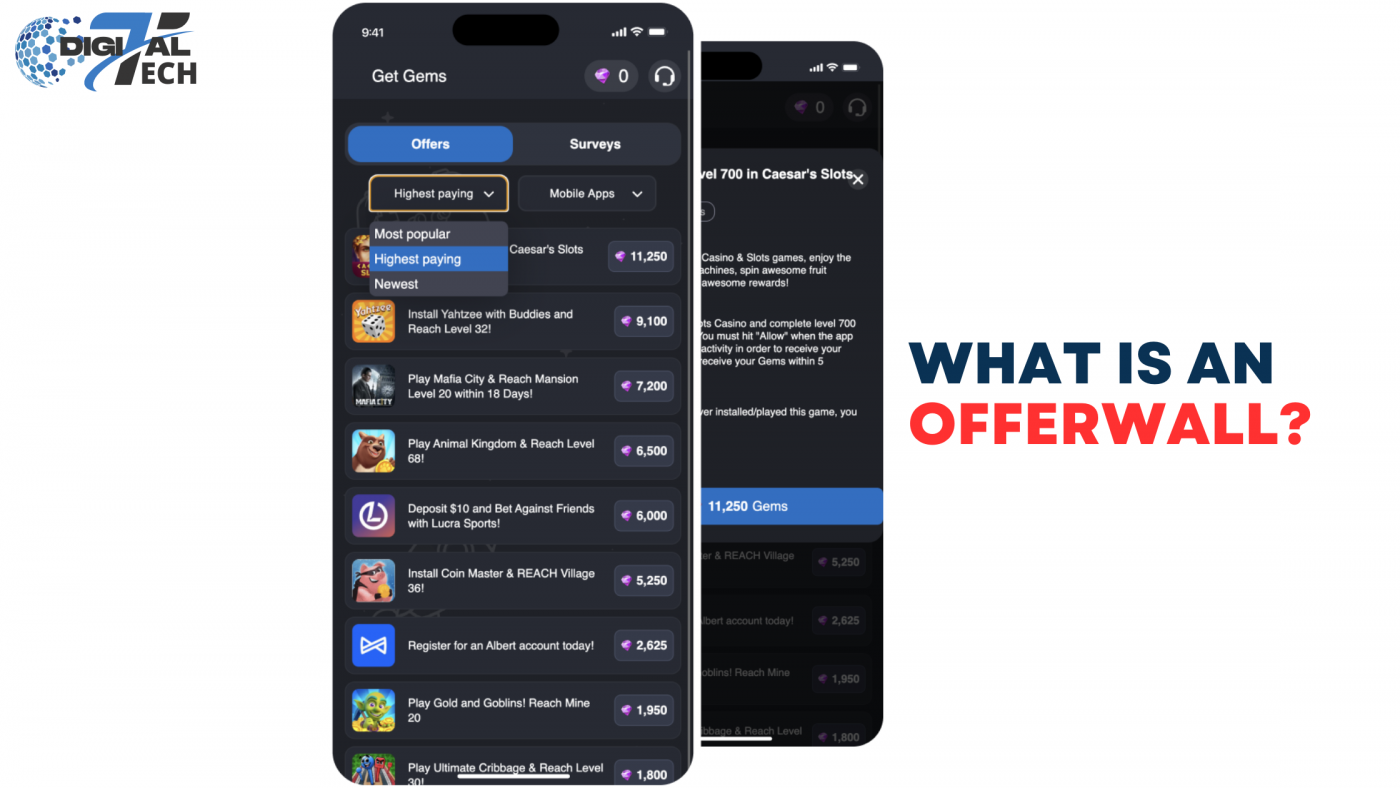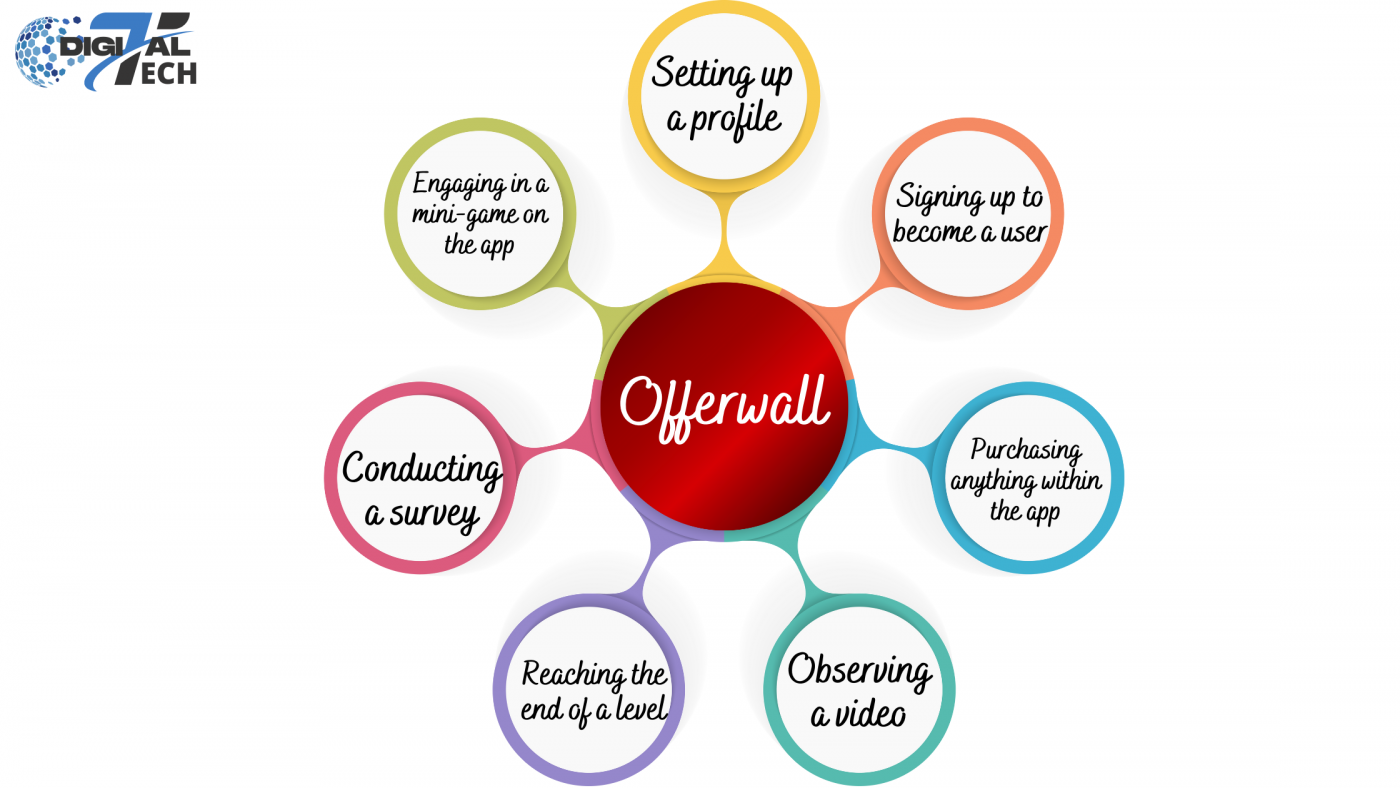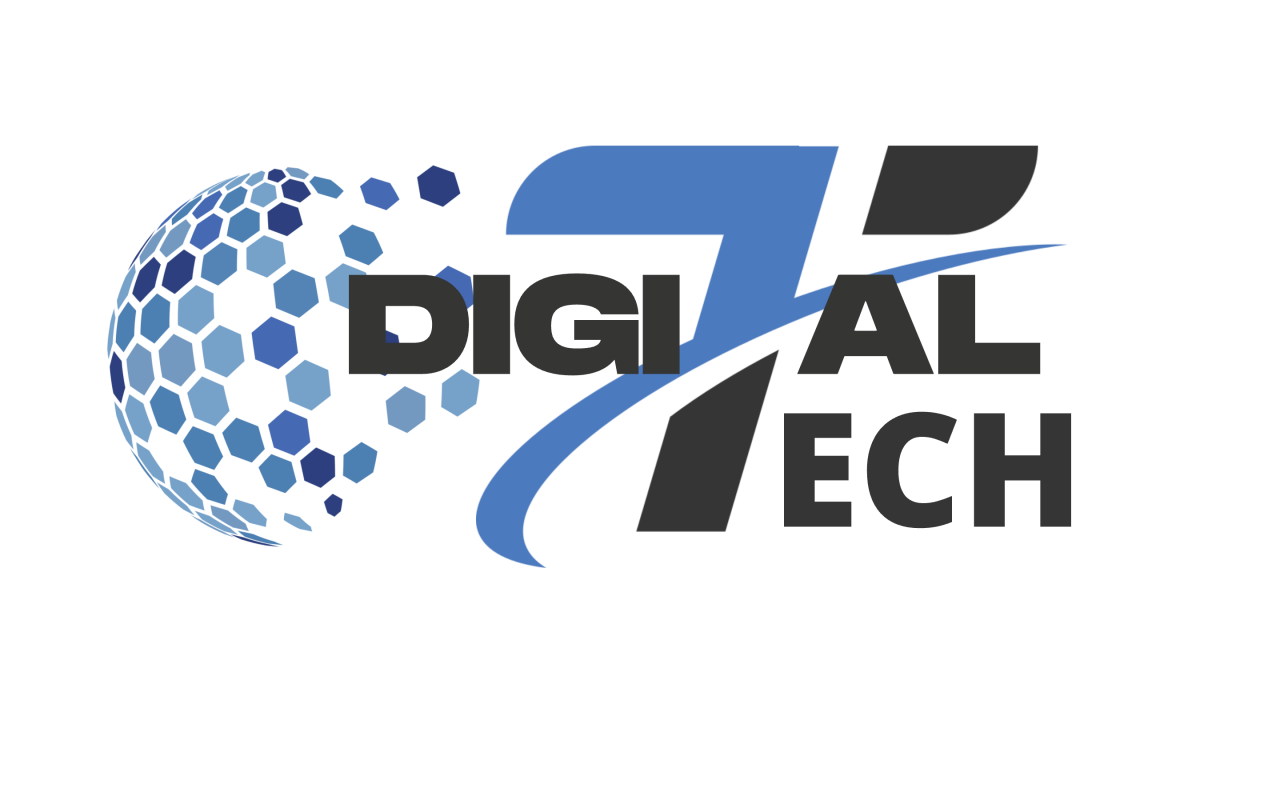Keeping your audience interested is crucial in this day and age when people’s attention spans are short and their patience is short. Offerwall advertisement have been an effective strategy for achieving this goal. Offerwall is revolutionizing the advertising technology industry with its unique approach to boosting app engagement and rewarding users. Let’s read the article in more detail to learn more about Offerwall.
1. What is an offerwall?
Ad units called offerwalls are used to monetize apps. It assists users in earning incentives upon fulfilling particular activities. It may contribute to increasing app traffic and user acquisition.

What is an offerwall?
To put it simply, it’s a wall of offers that encourage users to select an activity, do it, and receive rewards. These might be anything from opening an advertisement to creating an account on the app. Offerwalls are suitable for many types of websites and applications; however, they are most commonly utilized in gaming apps.
Offerwalls rank among the most popular choices, with 15% of game publishers using them, according to DataDNA. Because of this, Offerwall is a popular monetization method.
2. How does Offerwall work?
Offerwalls function as a sort of marketplace where app users and advertisers can transact. Advertisers create an offer at a predetermined price in an attempt to increase visitors. An ad-mediation platform then posts the offer on an app. The application incorporates the promotion into its user interface, allowing users to do tasks and earn various incentives. In addition to receiving payment for the benefits the user receives, the ad mediation service also receives a modest commission for the services it provides. The advertiser pays for the services of the ad mediation platform and the users’ compensation.

Offerwalls function as a sort of marketplace
Offerwalls are typically placed in strategic or high-traffic areas. A user will be enticed to win something here. Offerwalls come in a variety of forms, which are as follows:.
- Setting up a profile
- Signing up to become a user
- Purchasing anything within the app
- Observing a video
- Reaching the end of a level
- Conducting a survey
- Engaging in a mini-game on the app
If users choose to move on with any of the aforementioned options, they will be eligible for several incentives. Additional lives, an ad-free experience, in-app purchases, bonus points, external currencies or rewards, and more are some of these incentives.
3. What role do offerwalls play in monetization?
Offerwalls have proven to be a successful revenue strategy for creators of apps and video games. One can encourage users to remain engaged with their software by incorporating Offerwalls within it. Offerwalls aid in the following aspects of app monetization:
1. Enhanced interaction with users
Players can get a variety of incentives from Offerwall, such as bonus points, extra lives, or even money prizes. This encourages gamers to come back to the game and keep playing. A gamer is likely to be more devoted to the app the more invested they are because of the rewards. As a result, the app’s revenue and retention rate will rise. Additionally, these users are more likely to choose premium upgrades and in-app purchases, which raises the possibility of app revenue.
2. Personalized advertising
More dedicated players play midcore or hardcore games than hyper-casual ones. Offerwall guarantees app monetization by making sure these users receive snackable material and luring in more committed players. It also guarantees a gaming fit by default. This focused strategy improves the user experience and raises conversion and engagement rates. This demonstrates the tremendous monetization potential of Offerwall.
3. Elevated eCPM readings
Publishers receive excellent e-CPMs via offerwalls. Offerwalls frequently attract more devoted users to the app by carefully targeting their audience. Targeting highly engaged gamers with ad units increases the willingness of advertisers to spend money. Offerwalls, for instance, continue to serve offers into the game’s final stages. Users will probably stay on the app longer as a result of this. Consequently, it will increase revenue for the advertiser and aid in the app’s acquisition of loyal users.
4. Various sources of income
Offerwalls give app and game developers several opportunities to monetize their creations. Offerwall offers creative ways to make money aside from conventional in-app purchases and advertising. Through its partnership with advertisers who pay for user engagement such as sign-ups, surveys, or app installs, Offerwall has lessened the reliance of app developers on a single revenue stream. The possibility of app monetization may therefore rise as a result.
5. Cost-effective strategies
Offerwalls are incredibly economical and can take any of the three routes shown below:
- Cost Per Install (CPI): Only when a user installs the program does an advertiser pay a publisher or an ad network.
- Cost Per Engagement (CPE): When a user completes a specific game level, an advertiser only pays a publisher or ad network.
- Cost Per Lead (CPL): Only when a user registers with the app does an advertiser pay a publisher or an ad network.
Through adherence to these payment structures, Offerwall has made sure that customers only pay after completing a specific task. There is a larger return on investment as a result.
4. How Offerwalls can aid in acquiring new users
Offerwalls are an effective tactic to improve user retention and engagement. It goes without saying that they have proven to be a successful strategy for acquiring new users and drawing in excellent clients. Offerwalls can improve a user acquisition approach in a number of ways. They are listed in the following order:
1. User engagement with incentives
The majority of apps now prioritize meaningful, in-depth user involvement over rapid response times. Offerwalls provide enough opportunities for that, as they award points or incentives for accomplishing specific activities. Offerwall motivates users to interact with the app by offering rewards for completing these tasks. Additionally, it gives consumers the opportunity to learn more about the app, which boosts user acquisition and engagement.
2. Increasing bids in the busiest season
Every app has a peak period during which traffic is at its highest. Seasons of events and holidays are particularly crucial for this tactic. A wise strategy to take advantage of this circumstance is to use Offerwalls and raise bids at this moment. Higher visibility is typically the result of higher bids. The right offer and ad placement will encourage users to spend more time on the app. This will boost interaction and might even attract new users to the app.
3. Cross-promoting other applications
Offerwalls can use in-game chores or advertisements to cross-promote other mobile apps. When playing Candy Crush, for instance, a player will come across a film that, when finished, will award them with extra points or lives. The Clash of Clans app is a possible subject of the video. The Clash of Clans advertiser is going to introduce a new game to a lot of Candy Crush gamers by putting this video into an Offerwall. This will help Clash of Clans get more users while also improving user engagement and retention for the host app, Candy Crush.
4. Analytics-driven optimization
One can optimize their user acquisition (UA) strategy by examining user behavior, conversion rates, and data such as lifetime value (LTV) and return on ad spend (ROAS). Analyzing past data allows one to pinpoint the elements that draw consumers in and increase retention. With its assistance, one can create a Cost Per Engagement (CPE) campaign that would probably attract high-quality users.
5. Loops of viral referrals
Offerwalls can assist apps in leveraging the influence of word-of-mouth recommendations and viral marketing. Offerwalls can assist apps in gaining more users that are in the same niche as the users that referred them by rewarding users for referring their friends and family. In the end, this gives the app greater visibility and benefits for the users.
5. For an advertiser to run an Offerwall ad, what is required?
1. Offerwall Platform and Integration Code
In order to run Offerwalls, an advertiser must have access to an ad network or platform. Ideally, the platform should offer a single system for hosting and managing advertisements.
Additionally, an advertiser must obtain an Offerwall platform integration code or Software Development Kit (SDK). Advertisers can show Offerwalls to their users once they’ve included this code in their app.
2. An “advertiser account” on the Offerwall platform
It will be necessary for an advertiser to register on the Offerwall platform. To create and manage Offerwall ad campaigns, you must have an account.
3. Offerwall creatives
A collection of creatives, including pictures, headlines, descriptions, and more, is vital. These will show up as Offerwall advertisements and are crucial in drawing in new customers. Selecting the promos and offers that an advertiser wants to display on their Offerwall for users is also crucial.
Additionally, an advertiser must have a strong Offerwall prompt that informs users of what is expected of them. It functions as a call-to-action (CTA) button that informs the user of the campaign’s expectations. “Click to install the app” and “Watch the video and earn extra points” are two possible ways they can show up.
4. Tracking mechanisms
It is imperative to establish tools for tracking and reporting in order to ascertain the effectiveness of the Offerwall advertising campaign. Getting data on clicks, installs, post-installs, and other activities is always a wise move.
5. Budget and bid details
Setting a budget for Offerwall is essential to starting a campaign that works. When launching an Offerwall campaign, it’s critical to take into account variables like cost per action (CPA) and cost per install (CPI). Advertisers must submit their anticipated number of installs within a given time frame along with their bidding data.
6. For a publisher to run an Offerwall ad, what is required?
1. Offerwall integration platform
The Offerwall functionality must be integrated into the publisher’s website or mobile application. They can accomplish this by putting into practice the necessary integration code, or SDK, that the Offerwall platform offers.
2. A “publisher account” on the platform
It will be necessary for a publisher to register for an account on the Offerwall platform. To access the tools and options required to manage Offerwall ad placements, you must have an account.
3. Prioritizing UX and compliance
A publisher must prioritize user experience (UX), and there shouldn’t be too many offers on the Offerwall. The publisher’s app or website must seamlessly integrate with the Offerwall.
It is imperative for a publisher to guarantee that the offerings showcased adhere to all applicable laws and legislation.
4. Payment and revenue
Publishers need to be aware of the Offerwall platform’s revenue share plan and payment method. When users interact with the offerings in the Offerwall or finish tasks, publishers are paid.
5. Continuous tracking and management
To ensure that their present ad placements are effective, publishers need to conduct regular tests. It’s also critical to keep up with the most recent developments in terms of tools, trends, and rules offered by the Offerwall platform.
7. Requirements for adding Offerwall to games
It is preferable to use Offerwall on gaming apps. A few important requirements must be fulfilled in order to incorporate Offerwall into games. They are listed in the following order:
1. Strong economy of in-app purchases
In order for a user to click on an Offerwall reward and proceed with in-app purchases, it must be visually enticing. With an Offerwall, games with a strong economy that uses real money do well. They frequently result in strong engagement and long-term retention.
2. Create Offerwall placements
A major factor in raising eCPM is serving Offerwall advertising at the appropriate time and location, following user segmentation, and doing so in an original way. This degree of optimization will facilitate user interaction and, eventually, help retain users.
8. Benefits of Offerwalls
1. Enhanced interaction with users
Offerwalls feature games, entertaining incentives, deals, and more. Many people are interested in this, and it may stimulate active user interaction. App engagement rates will rise in comparison to conventional ad formats.
2. A wide range of inventory
Offerwalls have an extensive inventory that is likely to be of interest to a broad audience. Offerwalls can display a range of offers, from surveys and app downloads to subscriptions, bonus points, prizes, and more.
3. Incredibly adaptable
Publishers are free to display the Offerwalls anyway they see fit by altering their layout and look. This facilitates smooth connection with their website or app. The offers that are shown and where they are positioned in relation to the content of the app or website are also up to the publishers.
4. Non-disruptive User Experience
Offerwalls effortlessly integrate with the app to give users a non-intrusive experience. It gives consumers with a pleasant experience and naturally integrates into the app’s design. Devoted gamers will finish the rewarded tasks and thus use the app or website more frequently.
5. Monetizing those who don’t spend
A lot of app users refuse to spend money on in-app purchases. However, these people are more inclined to accept an offer or view a video in exchange for prizes. In essence, kids will probably use the app to get prizes. This is a practical method of making money off of each user that interacts with an app that uses Offerwalls.
9. Issues with utilizing Offerwall and strategies for resolving them
Utilizing Offerwalls can present some difficulties. The following are some typical problems and possible solutions:
1. Dangers of users switching to other apps
When one software cross-promotes another, consumers may choose to download the other instead. This can negatively impact the initial app’s user acquisition and engagement. By concentrating on re-engagement strategies with the first app, this can be fought.
2. Using In-App Purchases Too Much
Multiple in-app purchases may have an impact on the app’s revenue strategy. This can be resolved by striking the ideal ratio between a viable revenue model and the appropriate number of offers.
3. Ad weariness
If there are a lot of offers or if the same deals are shown frequently, users may become overwhelmed. Engagement levels may drop as a result of this. One way to combat this is by consistently changing and updating the offers to keep consumers interested.
10. Best practices for offerwall advertisements
1. Adding a logo to an Offerwall
Users are more likely to interact with the Offerwall if they believe it to be a necessary component of the app. Therefore, it’s critical to brand Offerwalls so that they blend in with the rest of the app. The Offerwall will probably draw in more people if it appears less like an advertisement and more like an engaging chore with rewards.
2. Segmenting users and customizing Offerwalls
Offerwalls elicit varied responses from different users. Additionally, people of all ages, genders, and locations utilize a variety of apps. It will be simpler to draw them in if you use Offerwalls to target them when their interests have been more precisely defined.
3. Unique sales
Enhancing user engagement and retention can be achieved by providing a reward that is doubled or tripled upon completion of a job. Users are enticed to do the chores by the sense of urgency created by holding special contests and awarding rewards for a limited time.
4. Test several different campaigns.
Run diverse Offerwall campaigns and provide varying incentives. Try out several approaches to see what gets people’s attention. A/B testing can also be used to find the most effective elements.
5. Maintaining fresh or updated offers
Offering fresh deals to users each time they access the app is a profitable strategy. An app user is more likely to stay engaged with it for a longer period of time if they receive different rewards for doing different activities.


Pingback: What are the best times to run Offerwall currency sales? - DigitalTech Media